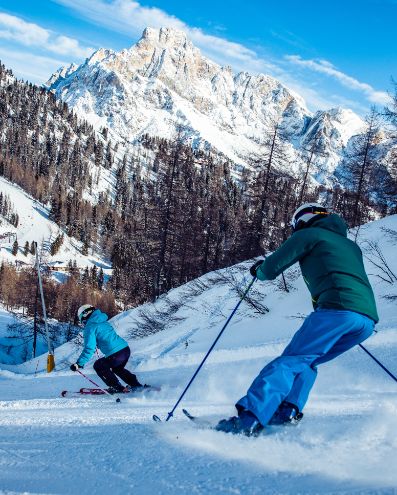San Martino di Castrozza
.jpg)
San Martino di Castrozza is at the foot of the Pale di San Martino, in the Dolomites, surrounded by a stunning UNESCO World Heritage Site. It has a long tradition of tourism reaching back to the 19th century, when the first English and German mountaineers arrived. The perfect destination for families and people who love an active holiday. The most stunning peaks in the area: the Cimon della Pala, the Vazzana, the Rosetta, and the Sass Maor.
Passo Rolle
.jpg)
This pass is at an altitude of almost 2,000 metres, connecting San Martino di Castrozza with the other valleys in the Dolomites. A small settlement at the top of the pass has everything you could want — hotels, restaurants, bars, and shops. What makes this place so special? Passo Rolle offers a unique view of the Pale di San Martino, which is the south-western gateway to the Dolomites, a UNESCO World Heritage Site.
Fiera di Primiero
.jpg)
This perfect little hamlet is home to 500 people, making it one of the smallest in Italy. Its history goes all the way back to the year 1400. At the time the town was part of the Austrian Empire; it had mines rich in copper, silver and iron, and underwent something of an economic boom. There are also historic buildings in the town including the churches of Madonna dell’Assunta, San Martino, Madonna dell’Aiuto, and the Palazzo delle Miniere (Miners’ Palace).
Siror
.jpg)
Almost as high as Fiera di Primiero, Siror is the northernmost community in the Primiero Valley, and has a partner city in Schönberg in the Stubai Valley. What do they have in common? A stunning panorama and an incredibly warm, welcoming atmosphere. Siror is particularly picturesque thanks to its large stone fountains and the old frescoes on the house fronts. The old town hall and Sant’Andrea parish church are well worth a visit. Fun fact: there’s an annual Christmas market in the town centre.
Tonadico
.jpg)
Tonadico has 1,500 residents and is the oldest settlement in the Primiero Valley. It lies below the ruins of Castel Pietra, and was once the valley’s administrative centre. The townscape is bursting with images of saints and beautiful murals from throughout the ages. When you’re out and about keep your eyes peeled for San Vittore church, built on a hill in the 11th century, and the even older Palazzo Scopoli which is currently a center dedicated to the local gastronomy.
Transacqua
.jpg)
Transacqua is home to 2,100 people, making it the most populous settlement in the Primiero area. Art lovers will really enjoy it here, admiring the parish church of San Marco and the Someda Renaissance palace which is a popular melting point for local and international artists and art enthusiasts. Its lovingly tended green spaces have earned Transacqua the international title of "Comune Fiorito" (flourishing municipality). The town’s economy is flourishing, too! In the 15th century, Transacqua was an important mining centre with some 500 pits.
Mezzano
.jpg)
Mezzano has fully earned its place among the "Borghi più belli d'Italia", the most beautiful hamlets and villages in Italy, with its charming inscriptions and façade paintings, but also its 400 gardens. They epitomise the entire village image and are a feast for the eyes, luscious in summer and snowy-white in winter. Just outside Mezzano, surrounded by a wide field, stands the picturesque church of San Giovanni, only an hour's walk from the centre of Mezzano.
Imèr

Imèr, with its stunning view of the Pale di San Martino, was a border area between Austria-Hungary and the Kingdom of Italy until the end of the First World War. The historic Sanctuary of San Silvestro is open to pilgrims every year on 31 December and 1 May, and is well worth a visit. On nearby Monte Vederna there’s a beautiful little alpine church dedicated to the Madonna della Neve. Foodies, plan accordingly — every September Imèr is host to the Knödelfest dumpling festival where you can try every kind of dumpling.








